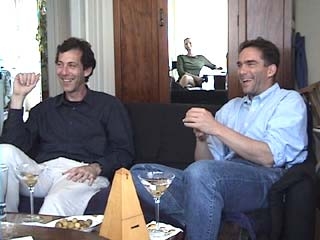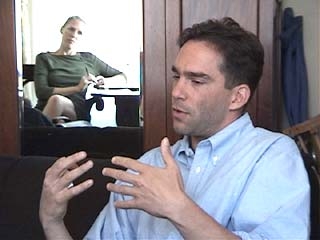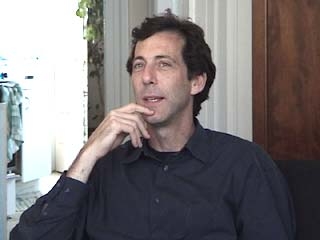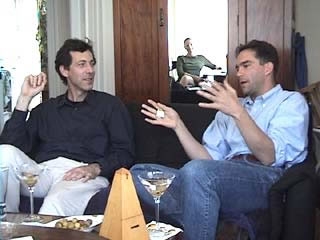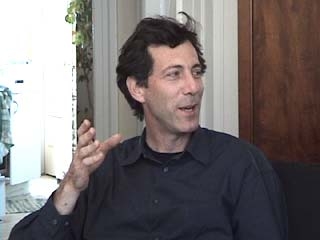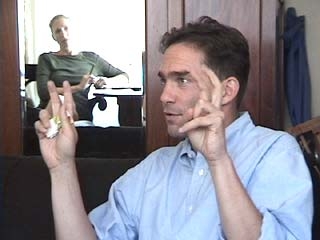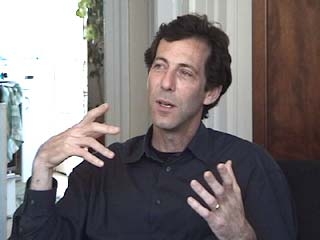Feature: Conversations
Larry Rinder and Ralph Rugoff in Conversation
Part II – The Blur between Art and Design
interview by Stretcher
Stretcher What drew you to this region (or pushed you away?)
Ralph It probably had very little to do with this region. The institute at CCAC isn’t devoted to representing this region. It’s also very much a conduit to what’s happening in the rest of the world- and hopefully, it will be a two-way conduit. Hopefully they’ll look at what’s happening in this region because I think that’s how you can create a unique art program but hopefully it will also look at what’s happening in the rest of the world that maybe is particularly relevant to this area and bring that in. In fact, I’m appalled by what’s happening here. It’s a great program and the whole thing, it’s a great idea. One of my questions actually for Larry might be just, when you envisioned this whole thing, where you saw it going eventually?
Larry You know, I didn’t have a really clear sense of it. I just loved the idea of a (it sounds kind of ghastly) but museum quality exhibition program in an art school setting. That combination to me seemed to be really potentially extremely dynamic. I was tired of working at Berkeley art museum where we had the no visitor phenomenon down pat. It was like, work, work and you’d go out into the museum and there was nobody there for ten years! To be in a situation where I could be in more of a discourse and dialog with visitors.
I don’t think I was there long enough to fully take advantage of that. I think that’s the tremendous opportunity at CCAC. You could go in so many wonderful directions like where it’s situated here in California, at this moment. If it weren’t for this terrible problem with housing for artists and students, and anyone with non-conventional notions or non-conventional income, anyway, it would be a very exciting time. I’m very worried about the economic problems.
RR in terms of people leaving…
LR ...people leaving, students not coming, influencing the types of students who do come, what they’re seeking, yeah.
RR Dave Hickey told someone who recently graduated from CCAC that San Francisco was the Bermuda Triangle for artists and they should immediately leave for LA.
LR LA is a so much more stimulating environment at the moment. And one really feels when you’re there that it’s one of the few places left in the United States where culture could happen - affordable for artists - and there are a lot of artists there. They leave from NY as well and they go to LA.
RR I think in some way, this area can take advantage of the fact that LA is an hour away by plane and have a close relationship to LA. I don’t think you can really compete with LA but instead, I think you can be a part of an experience and have more back and forth.
LR The exciting thing to do would be to do a program that was so phenomenal that LA would come here. I can’t think of a parallel in LA for the kind of institution CCAC Institute could be, combining intellectual reflection and analysis with international art exhibitions and architecture and design. That really is such a wonderfully neat package. If the silver lining of all this money here in San Francisco would be that it could sustain something like the Institute- to make it have the resources to pay leading intellectuals to come - from wherever they happen to be in the world to talk about things and to bring their artwork here. They may as well turn some of this money to good use. It’s an opportunity. And it may be that we all end up moving elsewhere but come back here for Institute programs. I mean, I think that the danger of San Francisco, is it becomes - it already is happening - Like Washington DC, a city for presentation rather than production. Let’s make the best of it. Let’s turn this into the best damn presentation place in Northern California.
Stretcher That comes back to your statements about all these biennials. Because when art is becoming this globalized art practice and artists are flying in from all over the world to present that work there, and then taking it and presenting it over here—does it matter anymore if an artist is from a region? I’m not really for regional identity because I think that it’s losing game, but what does it mean, this globalization process -and being a producer in a presenting city?
LR I think one thing is there’s a spate of artists who have emerged who have this posture that because they get to travel all over the world, that their lives exemplify the global condition and their art, which is about going to spend a month on the beach at St. Barths, is like somehow a metaphor for - it’s amazing and it’s just not true. So, I think that the local actually has not lost its relevance to our lives and it is true that art from around the world probably not as much because of travel, but more because of media, art magazines and probably, pedagogical strategies, is also developing a more homogenous look. But I think it’s probably superficial and if you dig a little below the surface you’ll find fundamental differences in the arts and even in different regions of the same country.
RR It’s tricky though because we’re no longer in the Renaissance where you have specific schools attached to specific areas because people didn’t travel that much and there wasn’t mass media. Any art school student now is reading all the art magazines, they’re looking at work that’s from all over the world. Ideas are filtering in from every which way. Sometimes they’re not acknowledged. I mean, I just got here from London and there’s a great deal of English art which owes its origins to American and German art but it’s never acknowledged. So Rachel Whiteread is making these casts of negative spaces for ten years before anyone mentions Bruce Nauman’s name, so sometimes there’s a detriment to a scene that’s too local and that it’s not aware of how interconnected all these things are. And the fact that you’re repeating something else that may have happened, at least in critical discourse, at least needs to acknowledge what the difference is in that repetition.
Stretcher And certainly the artist should have consciousness of that.
RR But there is a question of local identity for cities and I’m trying to ponder what it is for this city and I guess Rem Koolhaas, the architect that’s quoted recently in the paper here saying that ‘San Francisco wasn’t ready for its modernity’ and I’m wondering what that means. I mean driving around a little bit I get the sense that this doesn’t seem like a modern city. I know the population of San Francisco is the same today as it was in 1950. That’s not unique in urban areas, a lot of areas in the last 25 years, say haven’t grown because of flight to the suburbs. But that’s a pretty amazing statistic, where San Jose had, I think 50,000 people in 1950 and now has close to 1,000,000. Is this city a museum piece?
Stretcher There’s something about the natural environment here that’s unique as well. Like its preservation of space within an urban context.
RR So should we have more artists coming here who are doing interventions in public parks because that’s where everybody goes? And you won’t have the Berkeley Museum problem with nobody coming to the exhibition.
Stretcher Wouldn’t that put you out of a job?
RR No, I would just transform the galleries into something else and have our exhibits in parks.
Stretcher What would that something else be?
RR Well, I think you could start having an exhibition program in public parks.
LR But what would we do with the galleries?
RR Office space.
Stretcher The Modern has attracted lines around the block.
RR How much do you think is due to the building?
Stretcher A huge amount, obviously.
RR It did seem in the late 90’s museum buildings became more important than the art in the museums, as a spectacle.
Stretcher It’s part of the branding process.
LR I think that the SFMOMA is a disaster as a site for art viewing. Citing the building doesn’t begin to explain to me why people line up around the block.
Stretcher It’s the exhibition schedule isn’t it?
LR I don’t even think it’s that. They could show anything and people would line up around the block. They do some very smart things that are very simple. They have tea parties for hotel concierges. It’s one of the things it is the key, it really is. Concierges and taxi drivers.
RR You know, that’s very interesting. Tate Modern had an opening for cab drivers.
LR I can’t tell you how many people have been delivered to 7th Avenue and Irving Street and they’re trying to get to 7th and Irwin. I mean they end up out by the ocean and they’re looking for the CCAC Institute.
RR Finding ways to get people in to these institutions in a society where options for spending leisure time are extremely competitive.
LR Well, one of the things we did with CCAC Institute, from the beginning (which is again keeping with this notion of kind of a retrenchment) was to define our audience very explicitly as practicing artists, architects and designers in the spectrum of student to professional.
Stretcher And that’s one of the things about CCAC that I really like also is that interdisciplinary mix between design, architecture and art. I think that’s so important.
LR That was one of the things I think that we didn’t dig enough into in the time I was there. I think in retrospect- however, satisfying Searchlight was to me- I think probably, if I had that money to invest all over again, I would have done something about the the interface between art, architecture and design and really dug into what is the specificity of that in that institution and I think culturally here in the Bay Area, there’s a lot of people who reside in that space. That was something I think is a rich vein at CCAC and here.
Stretcher The fact that you chose to emphasize the metaphysical at the outset was a good way to start.
LR It was what was foremost in my mind and I think a curator is doing a disservice to everyone if they don’t do projects that are, what they find in their mind, because that’s where your passion is and you just have to kind of go with that. And I couldn’t really fake it. I actually find a lot of work that is on the intersection of art and design really dull and so, I mean, I think I’m getting to the point where I begin to see more about what the shape of that is and do that show, that I couldn’t back then.
Stretcher To me, it seems like it’s a really interesting point, in terms of dealing with those issues. Of the kind of fusion in a sense the art design blur
LR There’s this thing I sense percolating, of these really young people, like young lower 20’s who are artists, fashion designers and website designers and they have shops and they sell art and they sell tee shirts and they’re the same thing.
Stretcher And you can buy it online.
LR And you can buy it online. I better figure out what this is before it’s too late, but it’s going on. And it’s very interesting.
Stretcher LOT/EK was a really good example of an architecture show that I found very inspirational and also I think from the artist’s point of view, so many unbuilt projects. You’re constantly coming up with ideas for work. An artist doesn’t learn how to present that as a project. But architects do all the time.
RR You see a difference though between really interesting fashion or product design. And art. I mean you can go to the Comme des Garcons store in Chelsea, which is sort of almost like a parody of this Richard Serra thing that was at the Dia Center. And it’s a really fascinating experience. When the store was in Soho, some of the exhibitions there (you can almost call them exhibitions) the puff dresses, were more interesting than a lot of what was in the galleries. But somehow it seems like it’s trying for something a little different. And even though there are often these moments, when it seems like the line between art and other disciplines is dissolving, I just feel that a lot of the work doesn’t leave me with the same kinds of questions than an interesting piece of art does. That it’s often about a more immediate end. And to me, I guess that’s the very value of art. It somehow talks to the question center in your brain and leaves you asking things, and hopefully, sends you off in other places to find answers for those things, if there are answers.
Stretcher it’s that space of reflection.
RR Yeah, I don’t think design is often concerned with the same thing. I think architecture and design often have more immediate practical concerns and art is a very different kind of cultural space.
LR And then there is this new generation of people I’m talking about for whom these distinctions just don’t seem to matter. This artist came to see me at the museum, everyone tells me I shouldn’t just let artists come see me, but I do. He came, he had blue hair and he was probably 22 years old and he came in and he had briefcase. He knew he only had ten minutes. And he said, OK, Exhibit A, and he opened the briefcase and took out a sheet of slides. And he said, Well, only one of these actually exists. The other are all files and I’ll make them if anyone wants to buy them. His Exhibit B was stocks that he had issued for his corporation, which were also artworks. And Exhibit C is me. He took off his shirt. (which was frightening) And he had branded himself! He had tattooed himself with the logo of his art corporation. And it was like, it was a complete kind of, not ironic, I don’t think, corporatized art project. He said, it used to be that people wanted to fight against this and now we just see that this is reality. It was awful.
Stretcher We don’t see the point of not applying some kind of participation to that system in order to kind of turn the system upside down in a way - not resistant but…
LR ®TMark is certainly much more sophisticated, subversion or kind of camouflage of the capitalist enterprise. I mean, this guy, I don’t think had any kind of critical sense of what was going on.
Stretcher It’s more dangerous. This guy’s probably at that middle position between like working for a corporation and using it for material at the same time. That’s his reality in a certain sense.
LR And one of the interesting things I tried to ask him about the content of these paintings, his visual paintings of course, they have no content, they’re blank slates, basically. There’s these abstract patterns, they’re just fields for infinite projection of desire or whatever, it’s very peculiar.
RR I wonder how much all art is that?
LR exactly.
RR A friend of mine is a curator at Tate Modern and had to recently show a couple of princes from Nepal, I think, through the Tate Modern collection, and had to explain the Rothko room to them. She was trying to explain that these were actually expressions of the spiritual kind -and what that meant, and it was a culture that had no similar iconography, and she really got this sense, it’s really limited to the culture. You have certain cultural beliefs, that maybe you invest these objects with certain kinds of emotions and experiences and so they trigger things inside of you. But obviously, it’s nothing inherent in the object. It’s your cultural trigger.
LR Maybe that is the skill of an artist, to discern the trigger for a given culture. I think this notion of the trigger is resonating for me. That to me is more important than where someone went to school or whether they’re a professional artist or not. If they can pull the trigger on some experience, that for our culture, for no one else’s, really potent. That’s all that I care about.
RR I think that the gallery is a very specific type of technology. And that’s what you have to work with as a curator. Hackers are working with a different kind of technology. And a gallery lends itself to certain kinds of experiences. People keep trying to make galleries more peppy. They have interactive experiences. This has been going on since the ‘60s when there was a big attempt to bring ‘live art’ into the museum. And it is this quintessential ‘dead space’ and in some ways it’s an interesting aspect of it. Because we live in a culture which is so hyperactive. There’s so little of that kind of dead space in the mass media, say. There’s no dead air. And so maybe that can be turned into something interesting. I mean, maybe the role of the gallery is not to try to keep pace with contemporary culture but to be a kind of alternative view room, a place where there is dead air and now we’re talking about being more of a rear guard than an avante garde, something that’s looking and commenting on the culture whereas pretending to lead it into some brand new future.
Stretcher Is that the future of the art space, emptiness?
RR I know the first exhibition it looks like I’m working on for the Institute is going to be called (IN)Visible and it’s going to be a survey of invisible art, of which there was a great deal in the 60s and early 70s. Work that deals with a question of invisibility. I mean Tom Marioni actually created the first ‘Invisible Art’ show in 1969 at the Richmond Art Center, I think, called Invisible Painting Sculpture but it actually included works that were visible. And this show actually will be about works that you can’t see.
And it also deals specifically with the fact that you can’t see them. And to me, it just is an interesting time to deal with that because there’s so much emphasis on the visible, on things clamoring to grab your visual attention. It’s a continual challenge to me to figure out what is the nature of the gallery experience, what do you get out of that. And every gallery is different. Obviously the galleries at CCAC are immensely different from what Larry’s dealing with now at the Whitney situation which I’ve always found to be pretty inhospitable. But which I think can be, as the last biennial demonstrated to some extent, made much more hospitable. The weird thing you learn as a curator, and I’m sure you know this as an artist too, is how much a piece changes when it’s in a different space. And you realize that these things are not cut and dried things that look the same wherever you’re showing them. And as a curator you’re not that different from a zoological curator. You’re dealing with living things. Which need specific requirements.

